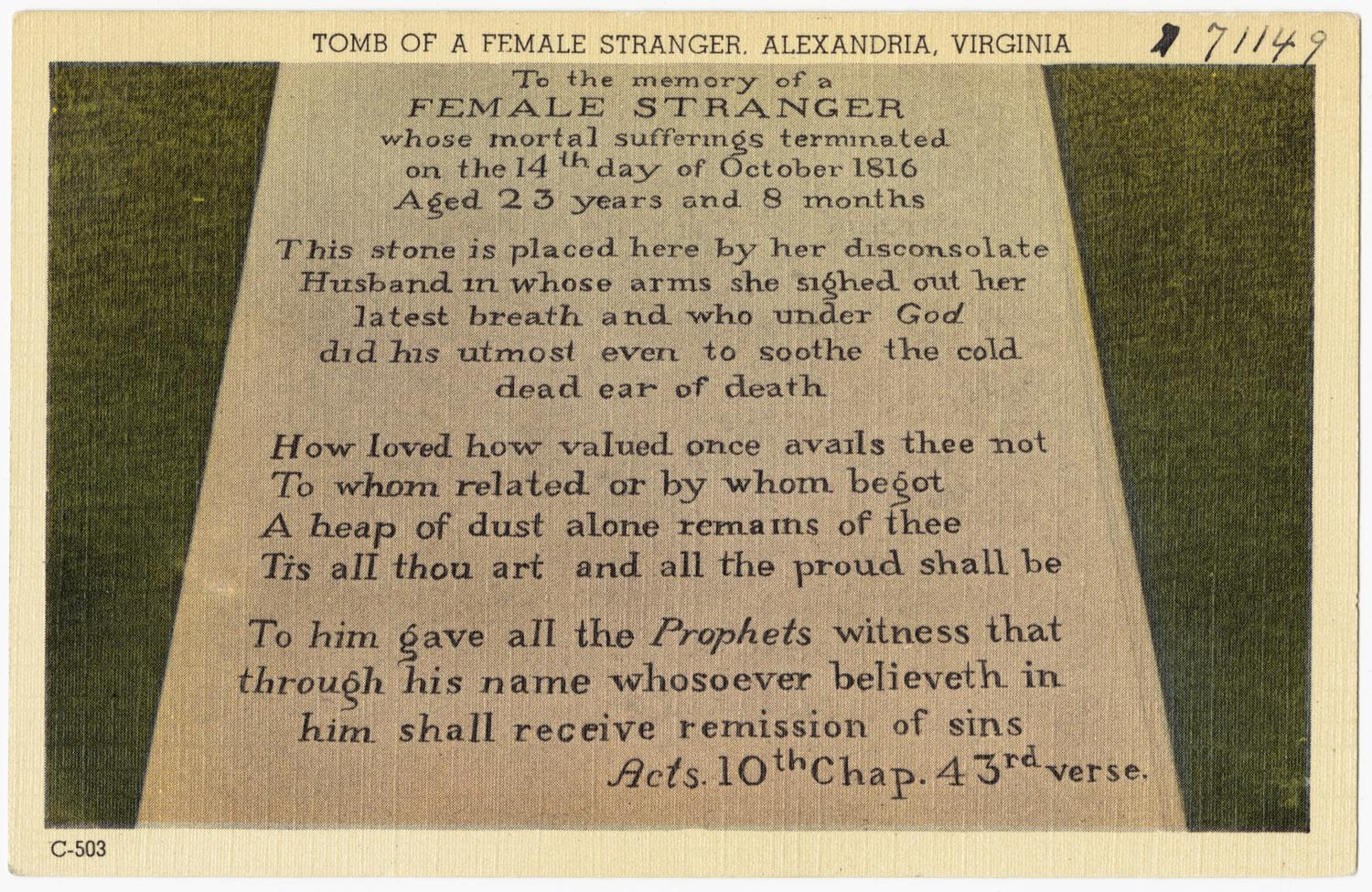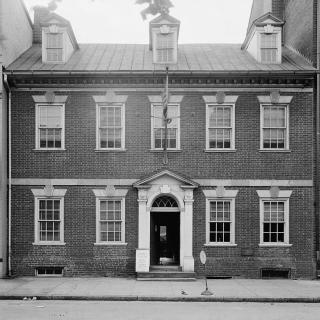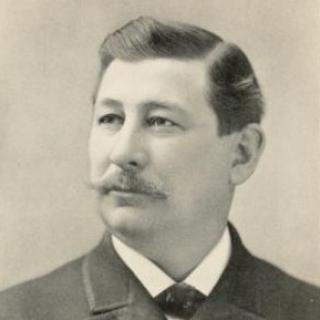The Female Stranger of Alexandria
Two hundred years ago, an unknown woman breathed her last in room 8 of Gadsby’s Tavern in Old Town Alexandria. Her husband prepared her body for death in secret and sealed her coffin personally. After seeing that she was placed in a local graveyard, he vanished. It’s the sort of story that would condemn a person to be lost to history, but the circumstances surrounding this woman’s death and interment sparked centuries of questions and outlandish theories. Even now, no one alive knows her name. She remains the Female Stranger of Alexandria.
The only concrete information about her identity is the inscription on her grave:
To the memory of a Female Stranger
whose mortal suffering terminated
on the 14th day of October, 1816
Aged 23 years, and 8 months
This stone is placed here by her disconsolate
Husband in whose arms she sighed out her
latest breath and who under God
did his utmost even to soothe the cold
dead ear of death
How loved how valued once avails thee not
To whom related or by whom begot
A heap of dust alone remains of thee
Tis all thou art and all the proud shall be
To him gave all the Prophets witness that
through his name whosoever believeth in
him shall receive remission of sins
Act. 10th Chap. 43rd verse.
This, of course, raises way more questions than it answers, the main question being: why would her disconsolate husband not include a name on her gravestone? In the years after her death, Alexandrians created many of their own imaginative answers to this question.
The most inspired versions cast the stranger and her husband as characters straight out of romantic literature, mysterious figures with tragic and illustrious pasts. These stories usually start with the couple arriving on a ship diverted to the Potomac in the summer for unknown reasons. The man is distinguished and well dressed; the woman is obscured by a long black veil. Giving no name, the two rent a room at Gadsby’s Tavern and sequester themselves away from the prying, questioning eyes of the townspeople. The husband is occasionally seen about town, but the stranger is confined to bed by a mysterious illness. The best doctor in the city is brought in by the husband and sworn to absolute secrecy. The stranger lingers in her illness for months, till it finally takes her in October. On the night in question, the doctor announces her impending death and the husband requests to sit with her alone and ...
A chill east wind rattled the sashes, a fine, cutting rain pattered against the window panes, and [the assembled] shuddered as they waited outside the death room door. Finally, at dawn, the husband with a haggard face and swollen eyes, stepped out into the hall and announced that all was over.[1]
Following her demise, the husband makes the unusual request to prepare and seal the coffin alone- further measures taken to obscure her identity. After the funeral, of which he is the only attendant, the husband drops off the map- no one even sees him leave. For a dozen years after, money arrives in the post for the upkeep of her grave. In the 1830s, the money stops coming, and it is assumed around town that the husband met his own end, one way or another.
A semi-popular sequel to this version of the tale tells that in the 1870s, two elderly and well-dressed women showed up in the graveyard with a male companion. Finding the graveyard keeper, the women complained heartily about the stranger’s grave not being taken care of. After hearing that no money had been provided for some years, the women opened their own purses on the spot. The intensely interested keeper was able to find out that the two women were relatives of the deceased lady, and that the husband had been a British officer, before the male companion hurriedly ushered the two women away.[2]
Discounting the sequel, the two conspiracy theories associated with this version connect the stranger to prominent disappearances of the early 1800s. The first names her as Theodosia Burr Alston- yes, that Theodosia Burr, of “Hamilton” fame. Alston was lost at sea in 1813, when the ship the Patriot disappeared in the Atlantic. A popular story was that the ship had been captured by pirates, and the Alexandria follow-up proposed that the ‘husband’ had been a pirate who faked their relationship to travel through Virginia undetected. This story is unlikely as Alston would have been over 30 in 1814 and probably would not have passed for 23.
The other theory names the stranger as Sarah Curran, an Irish woman who had an affair with an Irish revolutionist but was forced by her father to marry a British officer and- well, it’s a lot, but Thomas Moore is involved and anyway, Curran is too old for the 23 year mark as well.[3]
Discounting contemporary celebrities entirely, humbler versions of the stranger’s story did away with long veils and mysterious ships. The couple arrived in the usual way, taking a room at Gadsby’s without giving a name, which was not uncommon. The husband was a charming individual, and made the acquaintance of several townspeople. When the stranger died in October, the husband secured a loan from a prominent citizen to pay for the burial and the gravestone. As in the previous story, he prepares her and seals her coffin alone, and attends her funeral alone. When he disappears afterward, however, they call it ‘skipping town.’ In this story, the husband was a conman who swindled the town out of a great deal of money. The sequel for this version places the husband several years later in Sing Sing the notorious New York prison, sighted by an Alexandrian who brought the tale back.[4]
This latter story lends to the idea that the female stranger’s grave is actually empty. That her death went unwitnessed and the husband sealed her coffin in secret could mean that her death was a fiction to empty sympathetic pockets, and the two skipped town together.
Whether the female stranger of Alexandria was a tragic heroine or a clever trickster, her legend remains a core part of Alexandria’s folklore. Stories about her have persisted in the two centuries after her death; local brewery Port City even named a black IPA after her, “Long Black Veil.”* The true story behind this uniquely Alexandrian mystery will likely never be revealed but ghost tours keep the legend alive and likely will for centuries to come. You can visit her final resting place today in St. Paul’s Episcopal Church Cemetery to pay your respects, and if you ever figure out her story, be sure to let us know.
*If Port City were to send a case of Long Black Veil to the author for the purposes of research, that would be totally fine. Just sayin'.
Sources:
“The Female Stranger.” Alexandria Gazette, 27 May 1893. Chronicling America: Historic American Newspapers. Lib. of Congress.
“The Female Stranger: Anniversary of Death of Young Wife.” Alexandria Gazette, 11 Oct. 1916. Chronicling America: Historic American Newspapers. Lib. of Congress.
“The Female Stranger.” Alexandria Gazette., 01 June 1898. Chronicling America: Historic American Newspapers. Lib. of Congress.
“The Grave of the Stranger: A Story of Alexandria.” The Washington Times, 18 Dec 1901. Chronicling America: Historic American Newspapers. Lib. of Congress.
“An Oft-Told Story: Tomb of Female Stranger and Mystery.” Alexandria Gazette, 05 Oct. 1912. Chronicling America: Historic American Newspapers. Lib. of Congress.
“An Old Story is Retold: Ladies’ Home Journal Reproduces Account of Female Stranger.” Alexandria Gazette., 29 Aug. 1913. Chronicling America: Historic American Newspapers. Lib. of Congress.
Payne, L.E. “The Female Stranger.“ Alexandria Gazette, 05 Oct. 1897. Chronicling America: Historic American Newspapers. Lib. of Congress.
“A Reminiscence: Female Stranger, &c.” Alexandria Gazette, 20 July 1866. Chronicling America: Historic American Newspapers. Lib. of Congress.
“Romance of the Female Stranger.” Alexandria Gazette, 31 March 1922. Chronicling America: Historic American Newspapers. Lib. of Congress.
Footnotes






![Sketch of the mythical fuan by Pearson Scott Foresman. [Source: Wikipedia]](/sites/default/files/styles/crop_320x320/public/2023-10/Goatman_Wikipedia_Faun_2_%28PSF%29.png?h=64a074ff&itok=C9Qh-PE1)












